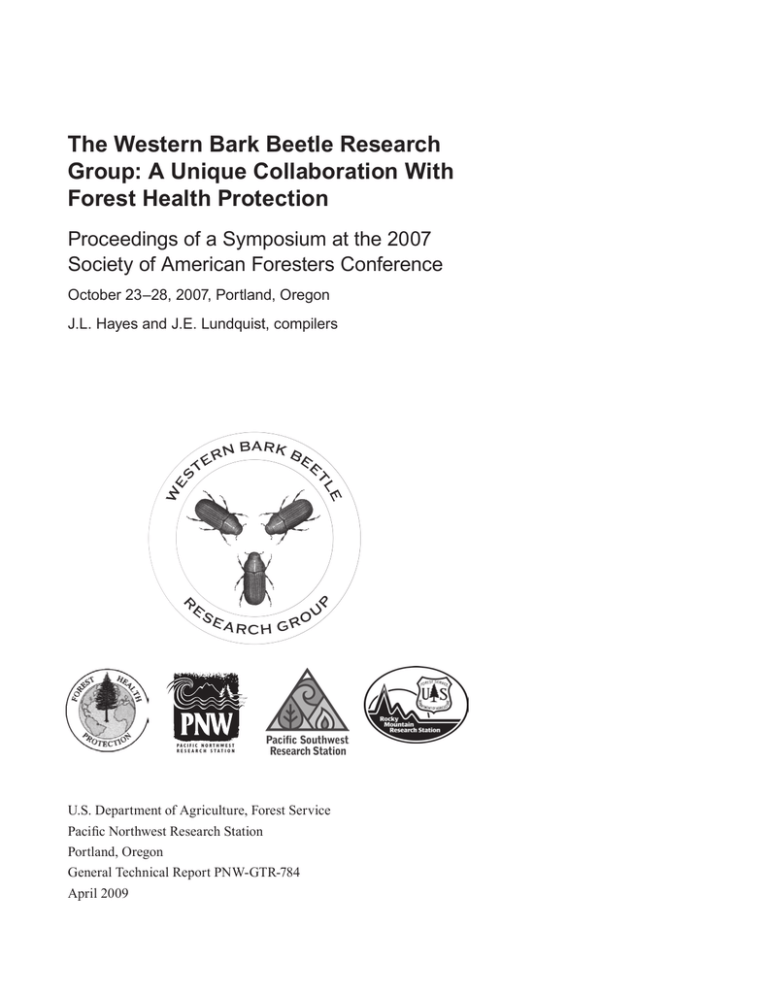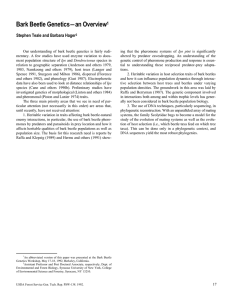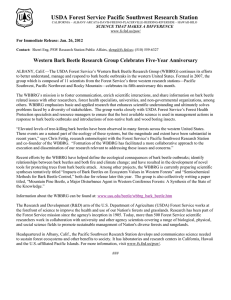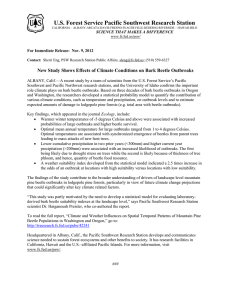The Western Bark Beetle Research Group: A Unique Collaboration With
advertisement

The Western Bark Beetle Research Group: A Unique Collaboration With Forest Health Protection Proceedings of a Symposium at the 2007 Society of American Foresters Conference October 23–28, 2007, Portland, Oregon J.L. Hayes and J.E. Lundquist, compilers PA C I F I C N O R T H W E S T RESEARCH STATION U.S. Department of Agriculture, Forest Service Pacific Northwest Research Station Portland, Oregon General Technical Report PNW-GTR-784 April 2009 Bark Beetles in a Changing Climate1 John E. Lundquist and Barbara J. Bentz2 Abstract Over the past decade, native bark beetles (Coleoptera: Curculionidae) have killed billions of trees across millions of hectares of forest from Alaska to Mexico. Although bark beetle infestations are a regular force of natural change in forested ecosystems, several current outbreaks occurring simultaneously across western North America are the largest and most severe in recorded history. Bark beetle ecology is complex and dynamic, and a variety of circumstances must coincide for a large scale bark beetle outbreak. While outbreak dynamics vary from bark beetle species to bark beetle species and from forest type to forest type, a combination of several factors appear to be driving current outbreaks, including a changing climate. Keywords: Global warming, climate change, latitudinal gradient, climate models, climate normals. ___________________ 1 The genesis of this manuscript was a presentation by the authors at the Western Bark Beetle Research Group—A Unique Collaboration with Forest Health Protection Symposium, Society of American Foresters Conference, 23–28 October 2007, Portland, OR. 2 John E. Lundquist is an Entomologist, USDA Forest Service, R-10 Forest Health Protection and Pacific Northwest Research Station, Anchorage, AK; email: jlundquist@fs.fed.us. Barbara J. Bentz is a Research Entomologist, USDA Forest Service, Rocky Mountain Research Station, Logan, UT; email: bbentz@fs.fed.us. 39 Introduction Over the past 100 years, global average temperature has risen by 0.74°C (0.56–0.92°C range). The greatest increase has occurred during the last two decades and experts say increases will continue (CIRMOUNT 2006). Predictions for increasing average global temperatures range from 1.0 °C to 4 ºC over the next 100 years (Houghton et al. 2001). There has also been a dramatic increase in the number of publications on climate change. An internet search of “climate change” finds over 60,000 hits in 2007 alone! Climate change may be one of the most focused topic areas in living history. The amazing interest in this topic is not easy to explain. Most would agree that the biological understanding and science underlying the climate change phenomenon has existed for at least a couple of decades (Houghton et al. 2001). But science alone has been inadequate in evoking such a response. Politics and the media apparently lined up just right with science causing climate change to emerge from “science” to a truly popular phenomenon (Boykoff 2007). What is climate change? “Climate” refers to the average state of the weather. Common weather phenomena are temperature, rain, snow, fog, wind, cloud, dust storms, and events such as tornadoes, hurricanes and ice storms. Weather usually refers to activity of these phenomena over short periods of time (hours or days) in localized areas. Climate refers to average atmospheric conditions over longer periods of time and involves broad areas. Although climate change is usually portrayed as increasing temperature, it actually expresses itself in many other ways as well; e.g., as changes in precipitation, UV-B radiation, atmospheric CO2, nitrogen deposition, and others. We see effects of climate change easier than we can experience a changing climate. These changes impact many things (Kolbert 2006, Parmesan 2006, Roy and Sparks 2000, Wohlforth 2002). We have heard about glaciers melting, flowers blooming earlier than in previous years, ocean levels rising and ocean-front villages washing to the sea, butterfly distributions migrating north (and one or two going south), and bark beetle outbreaks killing millions of hectares of forests. Climate is one of those unique phenomena that has the ability to effect nearly everything. It has been referred to as the “ultimate integrative field”. Why should we be interested in the effects of climate on herbivorous insects, like bark beetles? Insects have short life cycles, resulting in dozens or hundreds of generations in the time it takes most higher plants to complete one generation. Because insect life cycles are environmentally driven, a change in climate can significantly influence insect population timing and density. Monitoring insect population trends can then be used as an indirect measure of climate change. Furthermore, insects occur nearly everywhere and many can be studied year round. Insect pests can shape or change ecosystem structure and function, and, in doing so, act as catalysts of change. Insects can help maintain or 40 sustain ecosystems; displace or remove components of ecosystems; or lead to replacement of existing ecosystems. Insects can respond to long-term subtle shifts in their environment that are commonly so subtle that they cannot be directly experienced by humans. In short, insects can serve as a convenient bioindicator of climate change. Bark beetles, in particular, create the most visible of insect disturbances in a forest because they kill trees, lots of trees, and their impacts vary across all ecosystem services provided by a forest (Fettig et al. 2007). They influence nutrient cycling, energy flow, decomposition and other supporting services of ecosystems. They affect wood production and other provisioning services and goods of ecosystems. They influence water production, snow distribution and other regulating functions of ecosystems. They impact recreational experiences and other cultural services. They react quickly to changes in climate; much faster than higher plants including trees. Many bark beetle species have geographic distributions less extensive than their tree hosts (Ayres and Lombardero 2000), which suggests distributions could rapidly shift with climate change (Carroll et al. 2004). Climate change can directly affect bark beetle phenology and winter mortality, resulting in shifts in length and number of annual life cycles. Bark beetle communities will also be affected including predator/prey relationships, interactions with symbiotic fungi, forest structure, and forest vigor. Changes in temperature, precipitation and atmospheric gases will undoubtedly affect host tree defenses as well, possibly resulting in changes to bark beetle host specificity and geographic distribution. Rapid changes in climate may also result in genetic adaptations that create metapopulations (Balanya et al. 2006, Bradshaw and Holzapfel 2006). Spatial and temporal synchrony of beetles and their host trees may also be disrupted. Dramatic increase in outbreaks of bark beetles in the West Western U.S. states and Canadian provinces have recently seen a significant increase in bark beetle activity. Examples include pinyon ips (Ips confusus LeConte) on pinyon pine (mostly Pinus monophylla Torr. & Frem. and P. edulis Engelm.) in the southwestern U.S. (Breshears et al. 2005), spruce beetle (Dendroctonus rufipennis Kirby) in Alaska (Werner et al. 2006), mountain pine beetle (D. ponderosae Hopkins) along the Rocky Mountain Front Range in Colorado (Negrón and Popp 2004), in high elevation forests (Gibson 2006, Bentz and Schen-Langenheim 2007), and in interior British Columbia (Westfall and Ebata 2008). Climate change has been implicated as a major influencing factor (Berg et al. 2006, Breshears et al. 2005, Nijhuis 2004). Proving a direct correlation between climate and bark beetle outbreaks, however, is a difficult task. Understanding how climate affects the mechanics of bark beetle outbreaks is a challenge Climate affects everything in an already complicated biological system. For a bark beetle outbreak to occur, there must be suitable climate for several years, an active beetle population, and an extensive area of host trees of appropriate age, size and species (Fettig et al. 2007). Temperature, moisture and other climatic elements 41 symbolic of a changing climate can affect these requirements for a bark beetle outbreak. Outbreaks are often non-linear, unpredictable, sometimes unexpected events (Logan et al. 2003). Bark beetle outbreaks result from a unique combination of conditions at a variety of scales (Raffa et al. 2008). Elevated temperature and shifting precipitation patterns, in particular, appear to be influencing recent and current bark beetle outbreaks (Régnière and Bentz 2007, Shaw et al. 2005). Elevated temperatures can speed up reproductive and growth cycles and reduce cold-induced mortality during cold snaps (Bentz and Mullins 1999, Bentz et al. 1991, Logan and Bentz 1999). Although the relationship is nonlinear, prolonged drought can weaken trees, making them more susceptible to bark beetle attacks (Breshears et al. 2005, Mattson and Haack 1987, Waring and Cobb 1992). Because bark beetles are one component of a rich community comprising forest ecosystems, to fully understand climate change effects on bark beetles and hence forest ecosystems, we need to consider how climate change influences biotic interactions of symbiosis, competition, predation and other dynamic disturbance processes (Botkin et al. 2007). For example, Six and Bentz (2007) observed that temperature determines the relative presence of symbiotic fungi associated with mountain pine beetle. Although relationships are unclear at this time, it is obvious that climate change effects on fungal populations will have a cascading effect on mountain pine beetle population success. Effects of climate change on other critical components of bark beetle communities, including predators and parasites, are also unclear. Predicting climate and weather events of the future is a very difficult task Forecasts are less reliable the further out in time they project. Small, seemingly insignificant, changes can amplify to become major system shifts, which are unpredictable (Burkett et al. 2005). Because of a sensitivity to small changes, it will never be possible to make perfect forecasts (Holling 2001), although there still is much potential for improvement. Useful predictions of future insect activity will depend on reliable predictions of weather and a good understanding of cause/effect relations between weather/climate and insect physiology, behavior, and ecology (Stireman et al. 2005). Predicting the future involves some very complex mathematical models and very advanced, high capacity computers (McKenney et al. 2003, Rehfeldt et al. 2006, Williams and Liebhold 2002). Mechanistic mathematical models have been developed to describe and predict mountain pine beetle phenology (Bentz et al. 1991, Gilbert et al. 2004, Jenkins et al. 2001, Logan and Bentz 1999, Powell et al. 2000, Safranyik et al. 1975) and cold tolerance (Régnière and Bentz 2007), and spruce beetle voltinism (Hansen et al. 2001b). These models have been implemented within the BioSim (Régnière and StAmant 2007) modeling framework, enabling landscape-scale projections of population success given daily temperatures for the duration of a generation, one, two or three years depending on bark beetle species and geographic location. 42 Model results using climate-changed normals suggest that the probability of mountain pine beetle temperature-dependent survival in western U. S. over the next 25 yrs will generally increase. High-elevation forests will experience the greatest increase in probability of mountain pine beetle survival. The biggest increase in univoltine spruce beetle populations, and thus exponential population growth, is predicted to occur in Alaska and high-elevation areas of the western U.S. Historically, spruce beetle has had a two-year, or in some cases three-year, life cycle in these areas. Our ability to predict western U.S. bark beetle response to climate change is limited by a lack of data on species-specific temperature-dependent developmental processes. As described above, we do have models for mountain pine beetle and spruce beetle, although additional research is needed to parameterize existing models to account for regional genetic differences in population response to temperature. For other bark beetle species, our current ability to forecast climate change effects on population dynamics is almost entirely qualitative. What can we expect to happen to bark beetle populations as climate changes? Many possible scenarios have been proposed. In general, insect outbreaks are probably going to increase in number and severity (Ayres and Lombardero 2000, Stireman et al. 2005). Interactions between insects and their natural control agents (parasites, pathogens, predators, parasitoids) may be disrupted resulting in positive or negative effects on insect populations (Malmstrom and Raffa 2000). Host plant and insect phenological synchrony may be disrupted. Winter survival of insects may increase (Regniere and Bentz 2007, Williams and Liebhold 2002). Observed genetic adaptation to local environmental conditions (Bentz et al. 2001) suggest that bark beetles could rapidly respond to a changing climate. Exotic insects will have more opportunities to invade new areas and previously innocuous insects may shift hosts and become pests (Pernek et al. 2008). Distributions will shift northward in latitude and upward in elevation. Bark beetle species currently restricted to the southern U.S. and Mexico could expand northward. Northernmost forests will be affected first and most severely (Thomas et al. 2006). Bark beetle management under a changing climate Managers want to know what can be done to hedge against future effects under such a cloud of uncertainty. Several management coping strategies have been proposed including a change in forest structure and age patterns across landscapes, altered species composition and diversity, reduction in invasive species populations, prompt action when new invasives are detected, planting late successional species, and many others (Spittlehouse and Stewart 2003). Most of these suggestions are based on logic alone, since unprecedented conditions are facing managers. Few are based on statistically rigorous experimental research. Managers must be willing to accept that climate change will result in novel environmental conditions never experienced by current forest ecosystems, and dynamic strategies that enhance ecosystem adaptability will be required (Millar et al. 2007). 43 Conclusions Management traditionally has been aimed at recreating the past using such concepts as historical range of variability (Choi 2007). We treat the past as a stable state. We are beginning to realize now that we have no such stable state under a changing climate. We are tremendously challenged to predict what future suitably resilient environments will look like. The future is a moving target. One thing that is highly probable… the climate will change. Which way it changes is a question on many researchers and practitioners minds. Extrapolating the climate versus time curve is a challenging effort, and some believe that taking actions in response to climate change can create a bigger risk than doing nothing (Spittlehouse and Stewart 2003). There are many unanswered questions about potential effects of climate change on western bark beetle populations. Many will be difficult, perhaps impossible, to answer. Management of western U.S. forest ecosystems should be based on the best available science, a prospect facilitated by scientists within U.S. Forest Service Research and Development Western Bark Beetle Research Group. Acknowledgements We thank Ken Gibson, Mark Schultz, Chris Fettig, Aileen Holthaus, and Steve Patterson for reviewing earlier versions of this manuscript. This paper was originally presented at the 2007 Annual Meeting of the Society of American Foresters. We are grateful to SAF. Literature Cited Ayres, M.P.; Lombardero, M.J. 2000. Assessing the consequences of global change for forest disturbance from herbivores and pathogens. The Science of the Total Environment. 262: 263–286. Balanya, J.; Oller, J.M.; Huey, R.B.; Gilchrist, G.W.; Serra, L. 2006. Global genetic tracks global climate warming in Drosophila subobscura. Science. 313: 1773–1775. Bentz, B.J.; Mullins, D.E. 1999. Ecology of mountain pine beetle cold hardening in the Intermountain West. Environmental Entomology. 28(4): 577–587. Bentz, B.J.; Schen-Langenheim, G. 2007. The mountain pine beetle and whitebark pine waltz: has the music changed? Proceedings of the Conference Whitebark Pine: A Pacific Coast Perspective. http://www.fs.fed.us/r6/nr/fid/wbpine/papers/ 2007-wbp-impacts-bentz.pdf. Bentz, B.J.; Logan, J.A.; Amman, G.D. 1991. Temperature-dependent development of the mountain pine beetle (Coleoptera: Scolytidae) and simulation of its phenology. Canadian Entomologist. 123: 1083–1094. 44 Berg, E.E.; J.D. Henry; C.L.Fastie; A.D. De Volder; S.M. Matsuoka. 2006. Spruce beetle outbreaks on the Kenai Peninsula, Alaska, and Kluane National Park and Reserve, Yukon Territory: relationship to summer temperatures and regional differences in disturbance regimes. Forest Ecology and Management. 227: 219–232. Botkin, D.B.; Saxe, H.; Araújo, M.B.; Betts, R.; Bradshaw, R.H.W.; Cedhagen, T.; Chesson, P.; Dawson, T.P.; Etterson, J.R.; Faith, D.P.; Ferrier, S.; Guisan, A.; Hansen, A. S.; Hilbert, D.W.; Loehle, C.; Margules, C.; New, M.; Sobel, M.J.; Stockwell, D.R.B. 2007. Forecasting the effects of global warming on biodiversity. BioScience. 57: 227–236 Boykoff, M. 2007. Changing patterns in climate change reporting in United States and United Kingdom media. Presentation at Carbonundrums: making sense of climate change reporting around the world. Reuters Institute for the Study of Journalism & Environmental Change. June 27, 2007. http://www.eci.ox.ac.uk/ news/events/070727-carbonundrum/boykoff.pdf. (12 January 2009). Bradshaw, W.E.; Holzapfel, C.M. 2006. Evolutionary response to rapid climate change. Science. 312: 1477–1478. Breshears, D.D.; Cobb, N.S.; Rich, P.M.; Price, K.P.; Allen, C.D.; Balice, R.G.; Romme, W.H.; Kastens, J.H.; Floyd, M.L.; Belnap, J.; Anderson, J.J.; Myers, O.B.; Meyer, C.W. 2005. Regional vegetation die-off in response to globalchange-type drought. Proceedings of the National Academy of Science. 102: 15144–15148. Burkett, V.R.; Wilcox, D.A.; Stottlemyer, R.; Barrow, W.; Fagre, D.; Baron, J.; Price, J.; Nieldsen, J.L.; Allen, C.D.; Peterson, D.L.; Ruggerone, G.; Doyle, T. 2005. Nonlinear dynamics in ecosystem response to climatic change: case studies and policy implications. Ecological Complexity. 2: 357–394. Carroll, A.L.; Taylor, S.W.; Regniere, J.; Safranyik, L. 2004. Effects of climate change on range expansion by the mountain pine beetle in British Columbia. In: Shore, T.L.; Brooks, J.E.; Stone, J.E., eds. Mountain pine beetle symposium: challenges and solutions. October 30–31, 2003, Kelowna, British Columbia. Information Report BC-X-399. Victoria, BC: Natural Resources Canada, Canadian Forest Service, Pacific Forestry Centre. 298 p. Choi, Y.D. 2007. Restoration ecology to the future: a call for new paradigm. Restoration Ecology. 15(2): 351–353. 45 CIRMOUNT Committee. 2006. Mapping new terrain: climate change and America’s West. Report of the Consortium for Integrated Climate Research in Western Mountains (CIRMOUNT). Misc. Pub., PSW-MISC-77. Albany, CA: US Department of Agriculture, Forest Service, Pacific Southwest Research Station. 29 p. Fettig, C.J.; Klepzig, K.D.; Billings, R.F.; Munson, A.S.; Nebeker, T.E.; Negrón, J.F.; Nowak, J.T. 2007. The effectiveness of vegetation management practices for prevention and control of bark beetle outbreaks in coniferous forests of the western and southern United States. Forest Ecology and Management. 238: 24–53. Gibson, K. 2006. Mountain pine beetle conditions in whitebark pine stands in the greater Yellowstone ecosystem, 2006. Numbered Report 06-03. Missoula, MT: U.S. Department of Agriculture, Forest Service, Forest Health Protection. 7 p. Gilbert, E.; Powell, J.A.; Logan, J.A.; Bentz, B.J. 2004. Comparison of three models predicting developmental milestones given environmental and individual variation. Bulletin of Mathematical Biology. 66: 1821–1850. Hansen, E.M.; Bentz, B.J.; Turner, D.L. 2001a. Physiological basis for flexible voltinism in the spruce beetle (Coleoptera: Scolytidae). Canadian Entomologist. 133: 805–817. Hansen, E.M.; Bentz, B.J.; Turner, D.L. 2001b. Temperature-based model for predicting univoltine brood proportions in spruce beetle (Coleoptera: Scolytidae). Canadian Entomologist. 133: 827–841. Holling, C.S. 2001. Understanding the complexity of economic, ecological, and social systems. Ecosystems. 4: 390–403. Houghton, J.T.; Ding, Y.; Griggs, D.J.; Noguer, M.; van der Linden, P.J.; Dai, W.; Maskell, K.; Johnson, C.A., eds. 2001. Climate change 2001: the scientific basis. Contribution of Working Group I to the Third Assessment Report of the Intergovernmental Panel on Climate Change. Cambridge University Press, Cambridge and New York. 881 p. Jenkins, J.L.; Powell, J.A.; Logan, J.A.; Bentz, B.J. 2001. Low seasonal temperatures promote life cycle synchronization. Bulletin of Mathematical Biology. 63: 573-595. Kolbert, E. 2006. Field Notes from a Catastrophe: Man, Nature, and Climate Change. Atlantic Monthly Press, N.Y. 357 p. Logan, J.A.; Regniere, J.; Powell, J.A. 2003. Assessing the impact of global warming on forest pest dynamics. Frontiers in Ecology and the Environment. 1(3): 130–137. 46 Logan, J.A.; Bentz, B.J. 1999. Model analysis of mountain pine beetle (Coleoptera: Scolytidae) seasonality. Environmental Entomology. 28(6): 924–934. Malmstrom, C.M.; Raffa, K. F. 2000. Biotic disturbance agents in the boreal forest: considerations for vegetation change models. Global Change Biology. 6(1): 35–48. Mattson, W.J.; Haack, R.A. 1987. The role of drought in outbreaks of plant-eating insects. BioScience. 37: 110–118. McKenney, D.W.; Hopkin, A.A.; Campbell, K.L.; Mackey, B.G.; Roottit, R. 2003. Opportunities for improved risk assessments of exotic species in Canada using bioclimatic modeling. Environmental Monitoring and Assessment. 88: 445–461. Millar, C.I.; Stephenson, N.L.; Stephens, S.L. 2007. Climate change and forests of the future: managing in the face of uncertainty. Ecological Applications. 17(8): 2145–2151. Negrón, J.F.; Popp, J.B. 2004. Probability of ponderosa pine infestation by mountain pine beetle in the Colorado Front Range. Forest Ecology and Management. 191: 17–27. Nijhuis, M. 2004. Global warming’s unlikely harbingers. High Country News, July 19, 2004. Parmesan C. 2006. Ecological and evolutionary responses to recent climate change. Annual Review of Ecology, Evolution and Systematics. 37: 637–669. Pernek, M.; Pilas, I.; Vrbek, B.; Benko, M.; Hrasovec, B.; Milkovic, J. 2008. Forecasting the impact of the Gypsy moth on lowland hardwood forests by analyzing the cyclical pattern of population and climate data series. Forest Ecology and Management. 255: 1740-1748. Powell, J.A.; Jenkins, J.L.; Logan, J.A.; Bentz, B.J. 2000. Seasonal temperature alone can synchronize life cycles. Bulletin of Mathematical Biology. 62: 977–998. Raffa, K.F; Aukema, B.H.; Bentz, B.J.; Carroll, A.L.; Hicke, J.A.; Turner, M.G.; Romme, W.H. 2008. Cross-scale drivers of natural disturbances prone to anthropogenic amplification: dynamics of biome-wide bark beetle eruptions. BioScience. 58(6): 501–518. Régnière, J.; Bentz, B.J. 2007. Modeling cold tolerance in the mountain pine beetle, Dendroctonus ponderosae. Journal of Insect Physiology. 53: 559–572. Régnière J.; St-Amant, R. 2007. Stochastic simulation of daily air temperature and precipitation from monthly normals in North America north of Mexico. International Journal of Biometeorology. 51: 415–430. 47 Rehfeldt, G.E.; Crookston, N.L.; Warwell, M.V.; Evans, J.S. 2006. Empirical analyses of plant-climate relationships for the western United States. International Journal of Plant Science. 167: 1123–1150. Roy, D.B; Sparks, T.H. 2000. Phenology of British butterflies and climate change. Global Change Biology. 6: 407–-416. Safranyik L.; Shrimpton D.M.; Whitney H.S. 1975. .An interpretation of the interactions between lodgepole pine, the mountain pine beetle, and its associated blue stain fungi in western Canada. In: Baumgartner D.M., ed. Management of lodgepole pine ecosystems. Pullman, WA: Washington State University Cooperative Extension Service: 406–428. Shaw, J.D.; Steed, B.E.; DeBlander, L.T. 2005. Forest inventory and analysis (FIA) annual inventory answers the question: what is happening to pinyon-juniper woodlands? Journal of Forestry. 103: 280–285. Six, D.L.; Bentz, B.J. 2007. Temperature determines the relative abundance of symbionts in a multipartite bark beetle-fungus symbiosis. Microbial Ecology. 54: 112–118. Spittlehouse, D.L.; Stewart, R.B. 2003. Adaptation to climate change in forest management. BC Journal of Ecosystems and Management. 4(1). http://www.forrex.org/jem/2003/vol4/no1/art1.pdf. Stireman, J.O. III; Dyer, L.A.; Janzen, D.H.; Singer, M.S.; Lill, J.T.; Marquis, R.J.; Ricklefs, R.E.; Gentry, G.L.; Hallwachs, W.; Coley, P.D.; Barone, J.A.; Greeney, H.F.; Connahs, H.; Barbosa, P.; Morais, H.C.; Diniz, I.R. 2005. Climatic unpredictability and parasitism of caterpillars: implications of global warming. Proceedings of the National Academy of Sciences. 102: 17384–17387. Thomas, C.D.; Franco, A.M.A.; Hill, J.K. 2006. Range retractions and extinction in the face of climate warming. Trends in Ecology and Evolution. 21(8): 415–416. Waring, G.L.; Cobb, N.S. 1992. The impact of plant stress on herbivore population dynamics. In: Bernays, E., ed. Insect-plant interactions, vol. IV. Boca Raton, FL: CRC Press: 167–226. Werner, R.A.; Holsten, E.H. 1985. Effect of phloem temperature on development of spruce beetles in Alaska. In: Safrankik, L., ed. The role of the host in the population dynamics of forest insects. Victoria, BC: Forest Canada, Pacific Forest Centre: 155–163. Werner, R.A.; Holsten, E.H.; Matsuoka, S.M.; Burnside, R.E. 2006. Spruce beetles and forest ecosystems in south-central Alaska: a review of 30 years of research. Forest Ecology and Management. 227: 195–206. 48 Westfall, J.; Ebata, T. 2008. Summary of forest health conditions in British Columbia 2007. Pest Management Report No. 15. Victoria, BC: British Columbia Ministry of Forests, Forest Practices Branch. 81 p. http://www.llbc.leg.bc.ca/public/PubDocs/ bcdocs/354419/bc_forests_hlth_con_2007.pdf. Williams, D.W.; Liebhold, A.M. 2002. Climate change and the outbreak ranges of two North American bark beetles. Agricultural and Forest Entomology. 4: 87–99. Wohlforth, C. 2002. Spruce bark beetles and climate change. Alaska Magazine. March 2002. http://www.wohlforth.net/FullTextArticles.html (6 January 2009) 49




